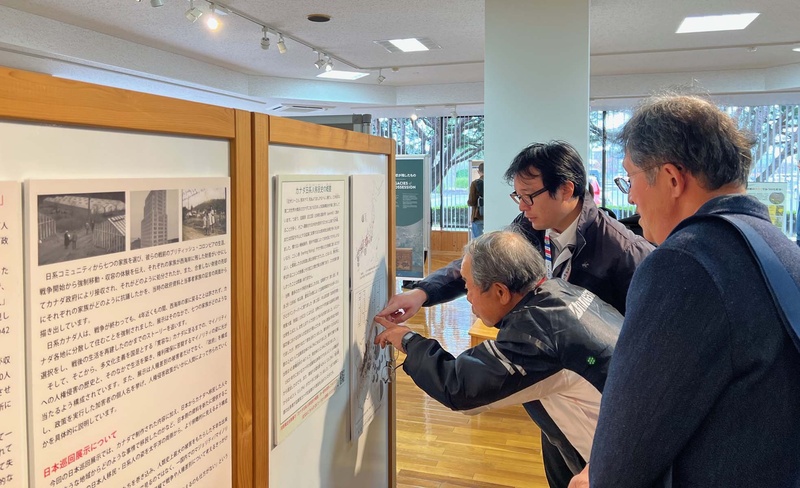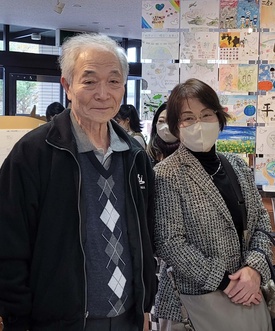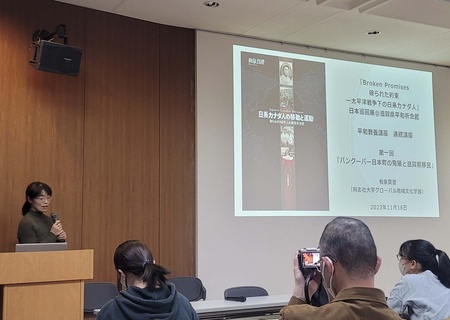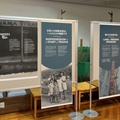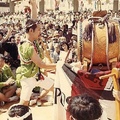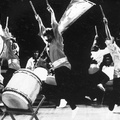From November 1, 2023 to February 25, 2024, the Shiga Peace Museum in Higashiomi, Shiga Prefecture, hosted Broken Promises: Japanese Canadians in the Pacific War, a travel exhibition on the wartime displacement and dispossession of Japanese Canadians.
In conjunction with the exhibition, on November 18, descendants of emigrants from Mio, Wakayama, to Canada and the students and teachers of “Kataribe Junior,” a youth group studying Wakayama’s emigration history, interacted with descendants of the Shiga emigrants and members of the local study groups in Shiga. This was probably the first time that emigrants’ descendants from Shiga, which sent the largest number of people to Canada, and those from Wakayama, which sent the second largest number, had the opportunity to interact with each other and with scholars of Japanese Canadian migration.
Local Emigration History Preservation Groups in Shiga and Wakayama Meet Each Other and Exchange Information
What was particularly memorable at this exchange event was the encounter between Mr. Satoshi Matsumiya, a local historian in Kaideima, Hikone, and Mrs. Takae Mio, the Director of the Canada Museum in Mio.
Mr. Satoshi Matsumiya’s grandfather, Sotojiro Matsumiya, was a successful immigrant from Shiga who owned a large general store on Powell Street in Vancouver’s Japantown. Sotojiro financially supported the Vancouver Asahi, a Nisei baseball team. The Vancouver Asahi began in 1914 as a sporting activity club for the Japanese Canadian boys on Powell Street. The team eventually grew to become the most popular amateur baseball team in British Columbia, with many non-Japanesefans.
Satoshi’s father, Masuo Matsumiya, was born in Canada, and after spending his school years in Japan, he returned to Canada to assist his father in runninghis store. Masuo was forcefully relocated to Grand Forks during World War II and was deported to Japan in 1946. He kept in touch with other returnees from Canada, and published the Kaideima Monogatari (Tales of Kaideima) in 1984, chronicling his hometown.
His ‘blood of a local historian’ was passed on to his son Satoshi, who self-published Matsumiya Shoten to Vancouver Asahi Gun (Matsumiya General Store and the Vancouver Asahi) in 2017, and Vancouver ni Yakyu Kurabu ga Atta Koro: Waga Sofu Matsumiya Sotojiro to Kanada Imin no Jidai (When Vancouver Had a Japanese Baseball Club: My Grandfather Sotojiro Matsumiya and the Era of Canadian Immigration) in 2022.
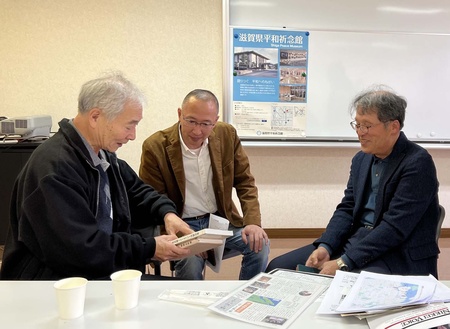
Mrs. Takae Mio is a native of Mio whose relatives and in-laws experienced Canadian immigration. In an effort to pass on Mio’s history to the future generations, she serves as the Director of the Canada Museum. She, in cooperation with researchers in Japan, is actively engaged in interviewing former emigrants from Wakayama Prefecture, particularly from Mio, preserving historical materials, and promoting the history of Canadian immigration among the general public.
Takae has also created a detailed illustration of the cemeteries in Mio, and she assists Japanese Canadians in search of their roots. The old and restored maps showing what the village used to look like have been extremely helpful in locating the addresses of the ancestral homes of the roots tourists from Canada.
Unlike in North America, there are no systematic ways to preserve emigration-related materials in museums or university libraries in Japan. Many letters, artifacts, photographs, and other materials lie in private homes without their true value being known. In order for researchers to access and preserve these materials, the presence and cooperation of local historians such as Satoshi Matsumiya and Takae Mio is essential. The exchange between the two active members of the two major former emigrant villages, Hikone and Mio, will greatly enhance the future research on Japanese migration to Canada.
Toward the Construction of a Community-Based Public History
The visit from Wakayama to Shiga was realized as part of a joint research project entitled “Establishment of Community-based Public History for the Development of the Next Generation through the History of Migration” (Grant-in-Aid for Scientific Research B, Project No. 21H03712, Project Head: Sachiko Kawakami).
The members of “Kataribe Junior” also participated in the meeting on November 18. Established in the spring of 2018, “Kataribe Junior” is a group of junior and senior high school students who study with teachers and other volunteers from the community, while also occasionally receiving English assistance from Stan Kirk, a Canadian associate professor at Konan University. The students collect interviews from the local elders, compile materials on Mio’s emigration history, prepare exhibition panels, and practice making presentations and conducting tours in English for Japanese Canadian visitors to Mio.
The 2023 the Kataribe Juniors went on a fieldwork tour of Vancouver, Steveston, and Vancouver Island for the first time since 2019. This initiative is an innovative way to preserve the emigration history of the Mio region as its activities offer the next generation a new image of the Japanese people and their sphere of life extending around the Pacific Rim. It also helps the students to realize the value of the historical materials buried in the region, which, it is hoped, will stimulate them to become interested in their home region and create new ways of thinking about its future.
Furthermore, this project aims to revitalize local communities and build a community-based public history through the educational development of the next generation by local NPOs. Its success or failure will also depend on whether the next generation will be able to reimagine the Japanese people with their scope of life extending overseas. Kataribe Junior’s efforts also encompass the possibility of sharing the know-how of passing on local history to the next generation together with local activists in other prefectures.
At this event, Eiji Horibe of the Iso Local History Club and others from the Iso district of Maibara City shared information about their ongoing efforts to excavate local history in Shiga. Horibe, a descendant of emigrants to Canada, leads this club, which has revealed that more than 230 people from Iso Village emigrated to Canada before World War II.
When they called on the community to provide documents related to emigration to Canada, they found two diaries written in Canada, in 1909 and 1918 respectively. These diaries are being analyzed by Aika Hirano, a graduate student at the Shiga Prefectural University. The fact that this meeting brought previously unknown local history research groups and professional researchers into contact with each other also made this meeting very significant.
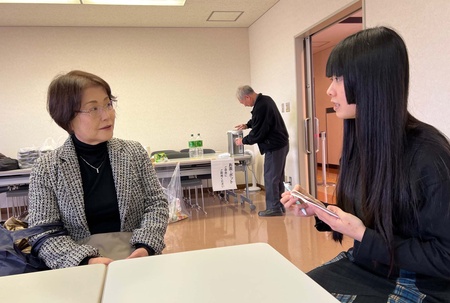
Masanobu Mio, one of the leaders of the “Kataribe Junior,” led the group’s tour from Wakayama to Shiga. According to Mr. Mio’s report, the Kataribe students could imagine the hardships experienced by Japanese Canadians as they viewed the exhibitions. Their imaginations were also stimulated by directly listening to Mr. Satoshi Matsumiya and seeingthe items he provided on display.
One student commented, “It was heartbreaking to read about the confiscation of the wealth the immigrants had built in Canada and the low prices their properties were sold for, and to think about the harsh conditions under which they labored.” Another student wrote, “Combining what I learned today with what I had learned before, I realized how hard the lives of Japanese Canadians had been.”
By learning about local history and witnessing the personal stories of immigrants and war survivors, the young people were able to imagine with compassion the hardships of immigrants who, in the eyes of these young people, would have merely been “people of the past.” History felt much closer to them on that day.
Providing Information about Japan Emigration History to the General Public
The Shiga Peace Museum holds monthly “Peace Education Lectures” open to all. The four sessions held from November 2023 to February 2024 were devoted to Japanese Canadian history, in conjunction with the Broken Promises exhibition.
November 18 was the first day of the four lectures. I, as a historian of Japanese emigration to North America, first explained the evolution of migration history research in Japan and the differences between immigrants to Canada from Wakayama and Shiga. My lecture was followed by Satoshi Matsumiya’s presentation titled “The Development of Vancouver Japantown and Immigration from Shiga,” in which he explained why many people emigrated from the Hikone area in the 1890s, pioneering the ethnic Japanese communities in Canada. Satoshi also showed many photographs of stores and businesses on Powell Street owned by Shiga immigrants, including his grandfather’s store.
Representing Wakayama, “Kataribe Junior” students gave a presentation on their regular activities and on their fieldwork in Canada during the summer. Other speakers included representatives from the Iso Local History Club and the Canada Museum in Mio. The Peace Education Lecture was a great success with nearly 30 participants.
Kataribe Junior’s comments also suggest that the event was useful for expanding the interest of young people in Japan’s migration history. Kataribe’s students wrote that they normally study only about emigrants from Wakayama. The event helped them think about migration from a broader perspective because they interacted with descendants of emigrants from other parts of Japan. They also learned about the differences in occupations, motives, and migration patterns between emigrants from Shiga and Wakayama Prefectures.
If we can stimulate public interest in the history of emigrants from other regions in Japan and the impact it has had on the respective regions, and if we can offer similar inquiry- and action-based learning activities to the younger generation in more regions, we will be able to expand the general knowledge about human migration and foster the next generation of citizens who will then be able to embrace local diversity in Japan from a global perspective.
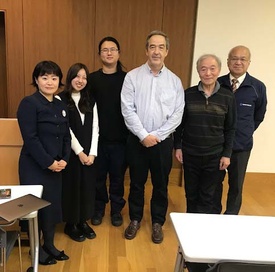
The second Peace Education Lecture was held on December 16, with Dr. Sachiko Kawakami, a member of the traveling exhibition executive committee, speaking on the topic of “Inheriting the History of Canadian Immigrants and Nurturing the Next Generation.” In addition to Dr. Kawakami, Mr. Haruji Mizuta, a second-generation Japanese Canadian who has compiled a list of emigrants from Mio, was featured in a pre-recorded video interview via Zoom from Canada. Professor Stan Kirk, who occasionally volunteers as a language assistant with “Kataribe Junior” students and has been collecting oral histories of Japanese Canadian deportees, introduced his research activities and how he teaches Japanese Canadian history to Japanese university students.
The third Peace Education Lecture was held on January 27, 2024, with Professor Kosuke Harayama giving a lecture titled “The Wartime Incarceration of Japanese Canadians.” On February 17, the final lecture of this series was given by Professor Norifumi Kawahara, under the title, “The Forgotten History of Japanese Immigration to Canada: Railway Contract Labourers at Rogers Pass.”
Through the Broken Promises exhibition, we were able to make more people in Japan aware of the experiences of Japanese migrants in Canada. The exhibition also generated more public awareness of the transnational connections hidden in local history. Globalization is not merely a recent phenomenon. I hope that many people will learn about the transnational lives experienced by the Japanese in the prewar period, an important part of our past that has been buried underneath the traumatic historical memories of war and colonialism.
Watch videos of the Peace Education Lectures of the Shiga Peace Memorial Museum >>
© 2024 Masumi Izumi


